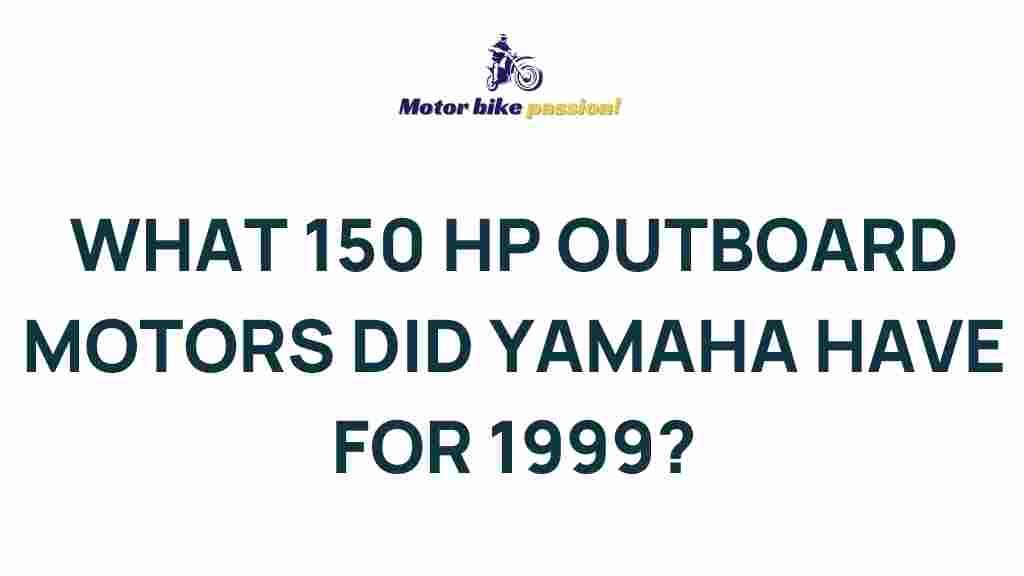Unveiling Yamaha’s 1999 Lineup of 150 HP Outboard Motors
When it comes to reliable and powerful outboard motors, Yamaha is a name that stands out in the boating industry. The year 1999 marked a significant year for Yamaha as they unveiled their lineup of 150 HP outboard motors. These motors have earned a reputation for their performance, efficiency, and durability, making them a preferred choice for boaters worldwide. In this article, we will explore Yamaha’s 1999 lineup of 150 HP outboard motors, discussing their features, benefits, and how to ensure they run smoothly.
Overview of Yamaha’s 1999 Outboard Motor Lineup
Yamaha’s 1999 lineup of 150 HP outboard motors includes several models designed to cater to different boating needs. The standout features of these motors include:
- Power and Performance: The 150 HP motors provide excellent acceleration and speed, making them suitable for various boating activities, including fishing, water sports, and leisure cruising.
- Fuel Efficiency: Yamaha prioritizes fuel efficiency in their designs, allowing boaters to save on fuel costs while still enjoying high performance.
- Durability: Built with high-quality materials, these outboard motors are designed to withstand harsh marine environments, ensuring longevity and reliability.
- Quiet Operation: Yamaha’s 1999 150 HP outboard motors are engineered for quiet operation, enhancing the overall boating experience.
Key Models in Yamaha’s 1999 150 HP Lineup
The 1999 lineup included several prominent models of 150 HP outboard motors. Here are a few key models:
- Yamaha 150TLRW: This two-stroke model was known for its exceptional torque and acceleration, making it ideal for high-performance applications.
- Yamaha 150TXRW: A versatile outboard motor, the TXRW model was favored for its reliability and smooth operation, perfect for both fresh and saltwater use.
- Yamaha 150HPDI: This high-pressure direct injection model offered increased fuel efficiency and lower emissions, aligning with Yamaha’s commitment to environmental responsibility.
Features of Yamaha’s 1999 150 HP Outboard Motors
Yamaha’s 1999 150 HP outboard motors come packed with features that enhance both performance and user experience. Here are some notable features:
1. Advanced Propulsion Technology
The 150 HP outboard motors utilize advanced propulsion technology that optimizes fuel consumption and boosts overall performance. This technology ensures that you get the most out of your motor, whether you’re cruising or towing.
2. Lightweight Design
Yamaha’s engineers focused on creating lightweight motors without compromising on strength and durability. The reduced weight of these engines allows for better handling and improved fuel efficiency.
3. User-Friendly Controls
With intuitive controls, Yamaha’s 1999 lineup makes it easy for boaters of all skill levels to operate their outboard motors. The simple throttle and gear shift designs enhance the overall boating experience.
4. Maintenance-Friendly
Yamaha designed these motors with maintenance in mind. Regular maintenance checks are straightforward, and parts are readily available, ensuring that boaters can keep their motors in peak condition without hassle.
Step-by-Step Guide to Maintaining Your Yamaha 150 HP Outboard Motor
Proper maintenance is crucial to prolonging the lifespan and enhancing the performance of your Yamaha outboard motor. Here’s a step-by-step guide to help you maintain your Yamaha 150 HP outboard motor:
Step 1: Regular Inspection
Perform regular inspections of your outboard motor to check for any signs of wear and tear. Look for:
- Corroded components
- Loose fittings or bolts
- Fuel leaks
Step 2: Change the Oil
Regular oil changes are essential for the smooth operation of your outboard motor. Follow these steps:
- Run the engine for a few minutes to warm the oil.
- Drain the old oil into a container.
- Replace the oil filter if applicable.
- Fill the engine with new oil as specified in the owner’s manual.
Step 3: Check the Fuel System
Ensure that your fuel system is clean and free from contaminants. Tips include:
- Inspect the fuel lines for cracks or leaks.
- Replace the fuel filter as per the maintenance schedule.
- Use fresh fuel to avoid issues related to stale gasoline.
Step 4: Inspect the Propeller
The propeller is a critical component of your outboard motor. Inspect it for:
- Dents or bends
- Debris stuck in the blades
- Wear and tear on the hub
Step 5: Winterization
If you live in a region with cold winters, proper winterization is crucial. This process includes:
- Flushing the engine with fresh water.
- Adding fuel stabilizer to the fuel tank.
- Storing the motor in a dry, protected area.
Troubleshooting Common Issues with Yamaha 150 HP Outboard Motors
Even the best outboard motors can encounter problems from time to time. Here are some common issues and their troubleshooting tips:
1. Motor Won’t Start
If your Yamaha 150 HP outboard motor won’t start, consider the following:
- Check the fuel level and ensure the fuel is fresh.
- Inspect the battery for charge and connections.
- Look for any blown fuses or loose wiring.
2. Overheating
If your motor is overheating, this could indicate:
- Clogged water intake or cooling passages.
- Low coolant levels (if applicable).
- A malfunctioning water pump.
3. Poor Performance
If you notice that your motor is not performing well, consider:
- Checking the propeller for damage.
- Inspecting the fuel system for blockages.
- Ensuring the air intake is clean and unobstructed.
Conclusion
Yamaha’s 1999 lineup of 150 HP outboard motors represents a blend of power, efficiency, and reliability that has made them a favorite among boaters. With their advanced technology and user-friendly features, these motors are ideal for various boating activities, ensuring an enjoyable experience on the water. By following a regular maintenance routine and being aware of troubleshooting tips, you can keep your Yamaha outboard motor running smoothly for years to come.
For more information on Yamaha outboard motors, visit the official Yamaha website. If you are looking for detailed guides on boating and maintenance, check out this resource for expert advice.
This article is in the category Reviews and created by MotorBikePassion Team

2 thoughts on “Unveiling Yamaha’s 1999 Lineup of 150 HP Outboard Motors”